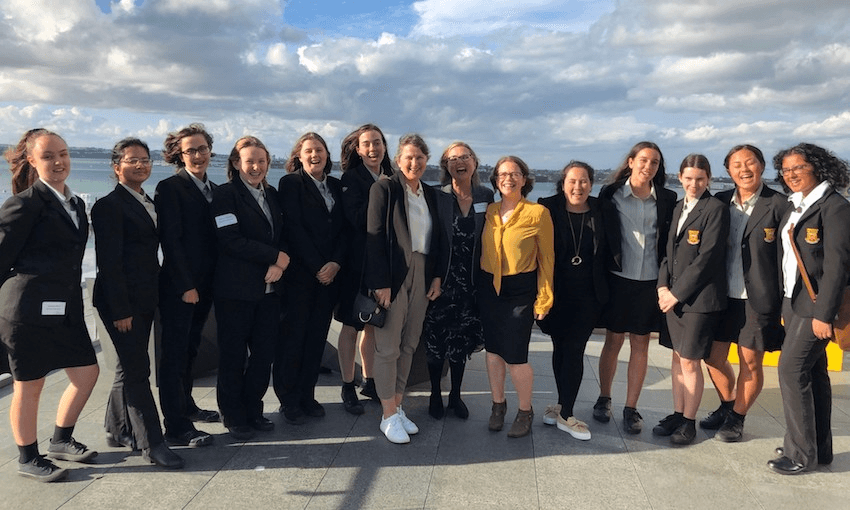Hannah Kronast attends a women’s empowerment panel focused on the huge disparities in training and employment within science and technology.
In the far back left-hand corner of a women’s equality and empowerment event, a male stuck up his hand. “What can men do to help?” he asked.
It was at a panel discussion earlier this month hosted by the Women’s Infrastructure Network and the Human Rights Commission and the male infiltration was welcomed. Influential New Zealand women had been assembled to encourage future influential New Zealand women to challenge the gender boundaries in employment and leadership in science, technology, engineering and mathematics (STEM). And the network has recently opened up its doors to allow more men to enter the conversation.
While women make up 64% of Bachelor of Science students, they’re over-represented in the health sciences and significantly under-represented in engineering and technology. Women represent less than a quarter of students studying engineering, just over a third studying IT. In the workforce, women make up just 13% of engineers.
Research also shows significant income gender disparity within Bachelor of Science graduates. More women science grads earn $50,000 or less, and more men earn larger salaries. Women in New Zealand are also under-represented in leadership roles in the research and academic sectors.
Alexia Hilbertidou was 16-years-old when she won a nationwide coding competition. She’d worked hard to prepare for it and was ecstatic when she found out she had won. “I was thrilled, this was my moment. I was 16 and I was on track to achieve my dreams and have a safe, secure, glamorous path into technology, something I had dreamed about since I was 8.”
When she entered her male-dominated IT class on her first day back at school she expected high fives, a standing ovation even. Instead, her classmates told her she had only won because she was a girl.
“I remember sitting there at 16 and this being a really defining moment for me. And after six months of putting up with insults I really broke down.”
She bounced back to create Girlboss, an organisation encouraging young women to consider careers in STEM and leadership.
This is why Hilbertidou wants men to join the movement to remove barriers for women entering studying and working in STEM fields. While numbers are slowly rising with the help of initiatives focused on women empowering women, men also have an essential part to play in the success of the movement.
Hilbertidou was part of the panel discussion, held at the EY offices in Auckland’s Takutai Square, with the Minister for Women Julie Anne Genter, Equal Employment Commissioner Saunoamaali’i Dr Karanina Sumeo, and EY’s Associate Director Dr Sophie Dawson. The four women had recently returned from the Commission on the Status of Women at the United Nations conference in New York. There they’d explored social protection systems, access to public services and sustainable infrastructure for gender equality and the empowerment of women and girls.
When the question from the male at the back of the room came up, each of them almost jumped to grab the microphone. Dawson took the mic with personal intent; her friend’s daughter who had been interested in science was told at the age of six that it wasn’t for her by other students in her class. She emphasised the importance of men helping and being more vocal about the issue.
“Men do tend to listen to other men and so if you do have some men that are supporting these changes then I think that the message will become more widespread and more people will become involved and changes will happen.”
She also noted that men can be hugely influential in whether a female gets the opportunity to travel these challenging paths and therefore it is crucial that they get involved. Dawson encouraged men to consider mentoring along with advocating for equality with their colleagues.
Hilbertidou started by thanking the four men at the event for coming. She encouraged more men to join at future events and said although it may be a little bit awkward to be in a room full of women, she guaranteed it wouldn’t be as awkward as it often feels to be a lone female in a STEM class. Her experiences were even more awkward because she didn’t fit what a stereotypical woman in STEM looks like.
“It wasn’t easy being a short, brown, outspoken female in this environment but I stuck at it,” she said.
She definitely isn’t the quiet-hiding-behind-glasses type. She wore a hot pink jacket. The panel’s diversity also showed that a woman in STEM can look like, act like, and be interested in anything. Dawson was more reserved but spoke passionately about her family and career which included designing the Airbus A380’s air conditioning. Sumeo held the motherly wisdom, and Genter’s political determination was steadfast. But one thing each of these women had in common was their drive and intelligence.
Hilbertidou said that having someone to aspire to be is super important, as women often need to be able to picture themselves in a role before believing they can do it. And that’s what the panel was doing that day. Harleen Bhathal, a year 12 student from Manurewa High School who attended the event with her peers as part of a partnership with EY, said she felt inspired by the speakers. She had previously talked herself out of trying a career in politics because it was daunting as a girl, but events like this empowered her to feel like she could do anything.
“For a bit I felt like I didn’t want to go into politics because everywhere I’d go, even to events, I’d just see a bunch of men and it’s kind of daunting being the only small girl in a room. But I really think that this event has just opened my eyes up again.”
